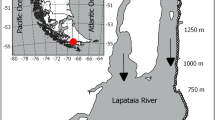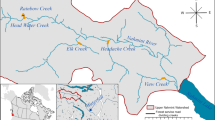Synopsis
Juvenile stocks of allopatric (upstream of barrier falls) cutthroat troutSalmo clarki and those sympatric (downstream of barrier falls) with coho salmonOncorhynchus kisutch and sculpinsCottus spp., were sampled during the late summer period of low flows in six small coastal streams in British Columbia. The objective was to obtain and compare information on pattern of habitat use and fish size distribution of these two trout types. In most instances, density (n m−2; g m−2) of cutthroat trout was considerably greater in pools and glides in the allopatric than in the sympatric stocks. The sympatric salmonids were dominated by juvenile coho salmon in pools and cutthroat trout in riffles. Sympatric cutthroat trout constituted from 7 to 45 % of the salmonids present in pools and from 50 to 90% in riffles. Glides were areas of intermediate densities for both salmonids, although coho salmon was the more abundant species in most instances. The density of sculpins was high in all three habitat types, and frequently it exceeded that of coho salmon and cutthroat trout combined. Sympatric cutthroat trout consisted primarily of underyearling fish, whereas allopatric cutthroat trout consisted primarily of two or more age classes with a large proportion of them living in pools. When tested in a laboratory stream both types of cutthroat trout had similar habitat preferences and agonistic behaviours, with the exception that allopatric trout made greater use of cover and defended pools more intensely than sympatric trout when the flow was increased. The results of this study provide insight of potential impact of coho salmon juvenile transplants into stream segments supporting allopatric cutthroat trout.
Similar content being viewed by others
References cited
Andreassen, S. 1971. Feeding habits of a sculpin (Cottus gobio L. Pisces) population. Ann. Rep. Inst. Freshw. Res. Drottningholm 51: 5–30.
Br¨cksen, R.W., G.E. Davis & C.E. Warren. 1968. Competition, food consumption and production of sculpins and trout in laboratory stream communities. J. Wildl. Manag. 32: 51–75.
Ciborowski, J.J.H. 1983. Influence of current velocity, density, and detritus on drift of two mayfly species (Ephemeroptera). Can. J. Zool. 61: 119–125.
Glova, G.J. 1984. Management implications of the distribution and diet of sympatric populations of juvenile coho salmon and coastal cutthroat trout in small streams in British Columbia, Canada. Prog. Fish — Cult. 46: 269–277.
Glova, G.J. 1986. Interaction for food and space between experimental populations of juvenile coho salmon (Oncorhynchus kisutch) and coastal cutthroat trout (Salmo clarki) in a laboratory stream. Hydrobiologia 131: 155–168.
Hartman, G.F. 1965. The role of behaviour in the ecology and interaction of underyearling coho salmon (Oncorhynchus kisutch) and steelhead trout (Salmo gairdneri). J. Fish. Res. Board Can. 22: 1035–1081.
Hildebrand, S.G. 1974. The relation of drift to benthos density and food level in an artificial stream. Limnol. Oceanog. 19: 951–957.
Mann, R.H.K. 1971. The populations, growth and production of fish in four small streams in southern England. J. Anim. Ecol. 40: 155–190.
Mason, J.C. 1976. Response of underyearling coho salmon to supplemental feeding in a natural stream. J. Wildl. Manag. 40: 755–788.
Mason, J.C. & D.W. Chapman. 1965. Significance of early emergence, environmental rearing capacity, and behavioural ecology of juvenile coho salmon in stream channels. J. Fish. Res. Board Can. 22: 173–190.
Mason, J.C. & S. Machidori. 1976. Populations of sympatric sculpins,Cottus aleuticus andC. asper in four adjacent salmon-producing coastal streams on Vancouver Island, B.C. U.S. Fish. Bull. 74: 131–141.
Petrosky, C.E. & T.F. Waters. 1975. Annual production by the slimy sculpin population of a small Minnesota trout stream. Trans. Amer. Fish. Soc. 104: 237–244.
Seber, G.A.F. & E.D. LeCren. 1967. Estimating population parameters from catches large relative to the population. J. Anim. Ecol. 36: 631–643.
Siegel, S. 1956. Nonparametric statistics for the behavioral sciences. McGraw-Hill Publishing Co. Ltd, New York. 312 pp.
Symons, P.E.K. 1971. Behavioral adjustment of population density to available food by Atlantic salmonSalmo salar. J. Anim. Ecol. 40: 569–587.
Wilzbach, M.A. 1985. Relative roles of food abundance and cover in determining the habitat distribution of stream-dwelling cutthroat trout (Salmo clarki). Can. J. Fish. Aquat. Sci. 42: 1668–1672.
Author information
Authors and Affiliations
Rights and permissions
About this article
Cite this article
Glova, G.J. Comparison of allopatric cutthroat trout stocks with those sympatric with coho salmon and sculpins in small streams. Environ Biol Fish 20, 275–284 (1987). https://doi.org/10.1007/BF00005298
Received:
Accepted:
Issue Date:
DOI: https://doi.org/10.1007/BF00005298




